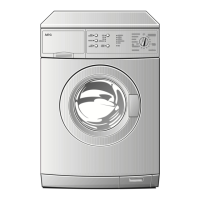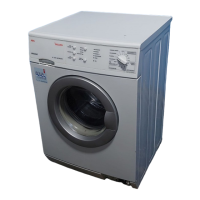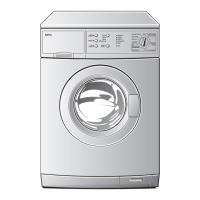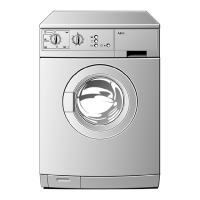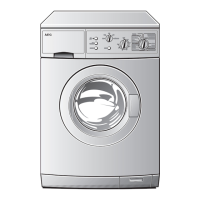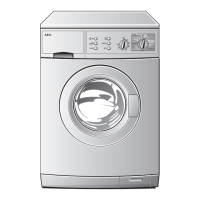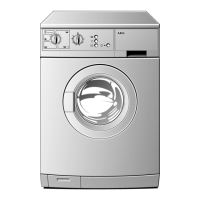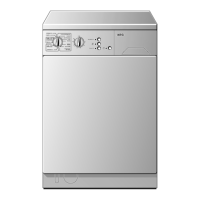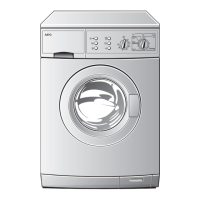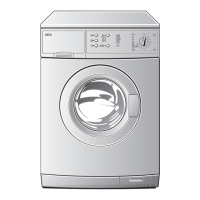Do you have a question about the AEG LAVAMAT W 1059 ELECTRONIC and is the answer not in the manual?
Information regarding the safety features of AEG electrical appliances and general safety guidelines.
Instructions to follow before the first use, including checking installation and acclimatizing the appliance.
Details on the appliance's intended use for domestic washing and restrictions on modifications or misuse.
Guidelines to protect children from hazards associated with packaging and operating the appliance.
Covers safe operation, maintenance, electrical safety, and precautions against heat and electric shock.
Information on recycling and proper disposal of packaging materials like plastic and cardboard.
Steps to take when disposing of the appliance to ensure safety, especially for children.
Diagram and labels identifying the main external parts of the washing machine.
Details the compartments within the detergent drawer for different types of cleaning agents.
Explanation of how to use the programme selector to choose wash cycles and temperatures.
Description of the function and use of various programme option buttons.
Details the main wash cycle for cottons and linens, including temperature range.
Description of the pre-wash function and its effect on spin cycles.
Description of the stain treatment option and temperature requirements.
Details the main wash cycle for delicate items, including temperature options.
Details the main wash cycle for woollen and silk items, including handwash symbol.
Details the shortened wash programme for lightly soiled washing.
Tables providing consumption values (water, energy) and times for selected programmes.
Guidelines on sorting laundry by care symbols, types, and preparing items for washing.
Explanation of care symbols and how they relate to washing types and programme selection.
Information on washing cotton items and suitable programmes.
Information on washing easy-care fabrics and suitable programmes.
Guidance on selecting suitable detergents and conditioners for automatic washing machines.
Factors influencing detergent quantity and recommendations for dosage adjustments.
Advice on using water softening agents based on water hardness classes.
Step-by-step guide to operating the washing machine for a wash cycle.
Instructions for actions to take after the washing cycle has finished, including door opening.
Instructions on how to open and close the washing machine door, including indicator lights.
Guidelines for loading laundry into the drum to ensure correct washing and prevent damage.
Details where to add main wash powder detergents and water softener.
Instructions for filling the compartment for liquid conditioners, softeners, and starches.
Details the compartment for pre-wash or stain treatment products, and for water softener.
How to use the programme selector to choose the appropriate wash cycle and temperature.
Instructions on how to select and cancel programme option buttons.
Detailed steps for setting spin speed or Rinse Hold using the dedicated button.
Explanation of spin speeds for different programmes when indicators are illuminated.
Guidance for when the programme fails to start due to the door not being closed properly.
How to pause and resume a washing programme.
Details on when and how to open the door after the washing cycle has finished.
Steps for taking the washed laundry out of the drum.
Instructions for turning the programme selector to OFF to shut down the appliance.
Details various washing programmes, their fabric types, load capacities, and temperature settings.
Specifics for the Cottons programme, including load and temperature.
Specifics for the Easy-cares programme, including load and temperature.
Details programmes for separate rinsing, suitable fabric types, and maximum load.
Details programmes for separate spinning, suitable fabric types, and maximum load.
Guidelines for cleaning the control panel and operating parts safely.
Instructions for running a maintenance wash to clean the drum.
Important safety warning to switch off and unplug the machine before cleaning the drain pump.
Instruction to perform emergency emptying before cleaning the drain pump.
Instructions for removing foreign objects, fluff, and fabric strands from the drain pump.
How to close and secure the emergency emptying hose after cleaning.
Instructions for closing the flap covering the drain pump access.
Table of problems, possible causes, and remedies for common washing machine malfunctions.
Troubleshooting steps for when the washing machine fails to start or operate.
Troubleshooting for issues preventing the door from closing properly, including child safety.
Causes and remedies for excessive vibration or noise during operation.
Causes and solutions for excessive foam generation during the main wash cycle.
Troubleshooting common causes of water leaks from the appliance.
Causes and remedies for laundry becoming heavily creased after washing.
Troubleshooting reasons for incomplete spinning and visible water in the drum.
Interpreting and resolving the error code indicated by 2 END light flashes and 2 beeps.
Troubleshooting why the door remains locked after the programme has ended.
Causes and remedies for detergent residue accumulation in the dispenser drawer.
Explanation for cloudy rinse water and its impact on results.
Troubleshooting why a programme option indicator might not illuminate.
Causes and solutions for greyish laundry and limescale buildup in the drum.
Troubleshooting persistent grey stains on clothes, often related to detergent or fabric softener.
Causes and solutions for white residues on laundry, often linked to detergent type.
Situations requiring emergency emptying, such as pump failure or freezing temperatures.
Crucial safety warnings regarding unplugging the machine and hot water before emergency emptying.
How to open the flap to access the emergency emptying hose.
Step-by-step guide to activate the RINSE+ feature for selected programmes.
Step-by-step guide to deactivate the RINSE+ feature.
Instructions on using a coin to turn the rotary knob inside the door to set the feature.
Warning about the correct positioning of the rotary knob for the child safety feature to be active.
Instructions on how to turn the rotary knob anticlockwise to deactivate the feature.
Essential safety measures to follow before, during, and after installing the appliance.
Crucial step to remove all transit packaging and bolts to prevent damage.
Requirement for using a correctly installed earthed socket for the appliance's plug.
Precautions and methods for safely transporting the washing machine.
Detailed steps for removing all transit packaging and securing components.
Instructions for firmly pulling off the hose holders.
Instructions for removing the transit screw D and compression spring using the special spanner.
Instructions for removing transit screws E using the special spanner.
Instructions for removing the four transit screws F.
Instructions for removing the transit bar G.
Ensuring the installation surface is clean, dry, and level, avoiding deep pile carpets.
How to compensate for minor floor unevenness using adjustable feet, not shims.
Warning against installing the appliance in areas susceptible to freezing temperatures.
How to adjust the appliance's height and levelness using the four adjustable screw feet.
Using a spirit level to confirm the appliance is correctly levelled.
Warning against using unsuitable materials like wood or cardboard for levelling.
Critical warning that the appliance must be earthed for safety.
Ensuring the mains voltage matches the appliance's rating plate before operation.
Instructions for connecting the green/yellow wire to the earth terminal.
Warning about the safety hazard of a cut-off plug in a 13 amp socket.
Requirements for making a permanent electrical connection, including switch installation.
Details on installing a double pole switch for permanent electrical connections.
Warning that only trained personnel should perform repairs on electrical appliances.
Crucial warning that the appliance must only be connected to cold water supplies.
Recommendation to use only new hose sets for connecting the appliance.
Information on the acceptable water pressure range for the appliance.
Specifies the minimum (1 bar) and maximum (10 bar) water pressure for operation.
Crucial warning against cutting hoses to extend them.
Instructions for connecting the angled end of the inlet hose to the washing machine.
Procedure to check the water connection for leaks by slowly opening the tap.
Warning emphasizing the importance of laying the drain hose without kinks.
Specifies maximum and minimum height limits for the drain hose when discharging into a standpipe.
Instructions for draining the hose into a sink, ensuring the sink is clear and the hose is not submerged.
Crucial warning against submerging the drain hose end to prevent water being sucked back.
Information about the washing machine's pump capacity and advice for higher drainage heads.
Specifies the maximum load capacity of the machine.
Information related to drum speed and spinning capabilities.
Covers validity period, coverage, exclusions, and procedures for repairs.
Lists common exclusions from the guarantee, such as misuse, neglect, and incorrect installation.
Instructions on how to contact customer service for guarantee repairs.
Guidance on contacting the local AEG Service Force Centre for faults.
Requirement for proof of purchase for any service calls covered by the guarantee.
List of information required when contacting customer support for assistance.
